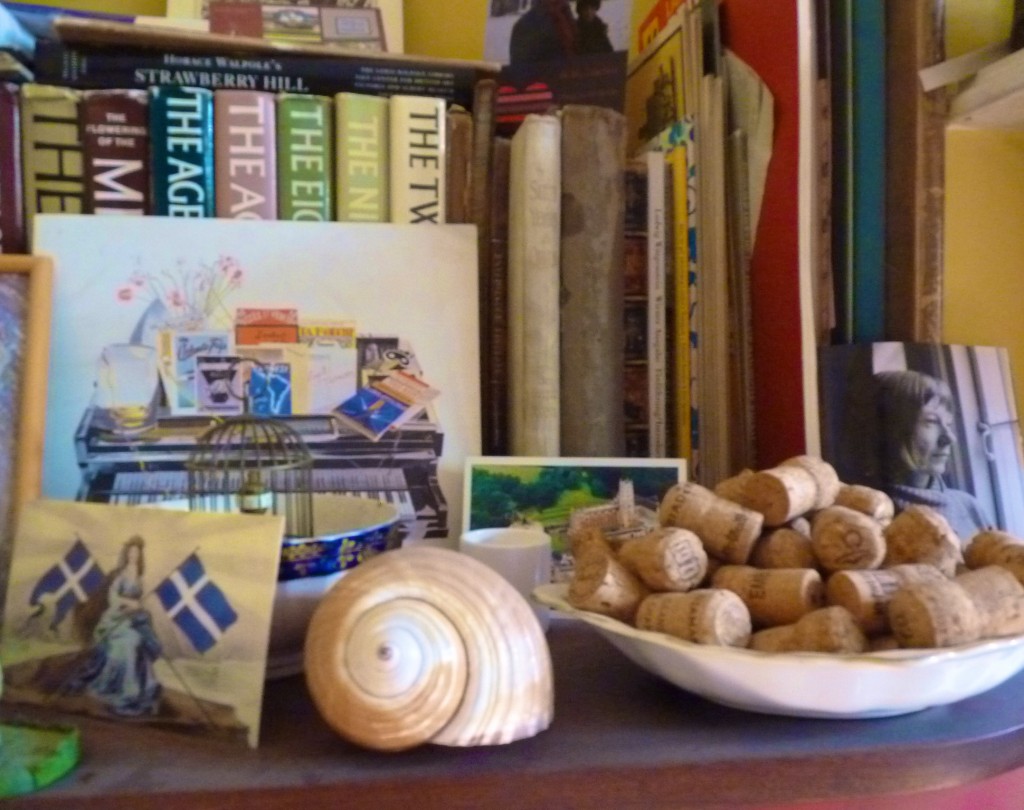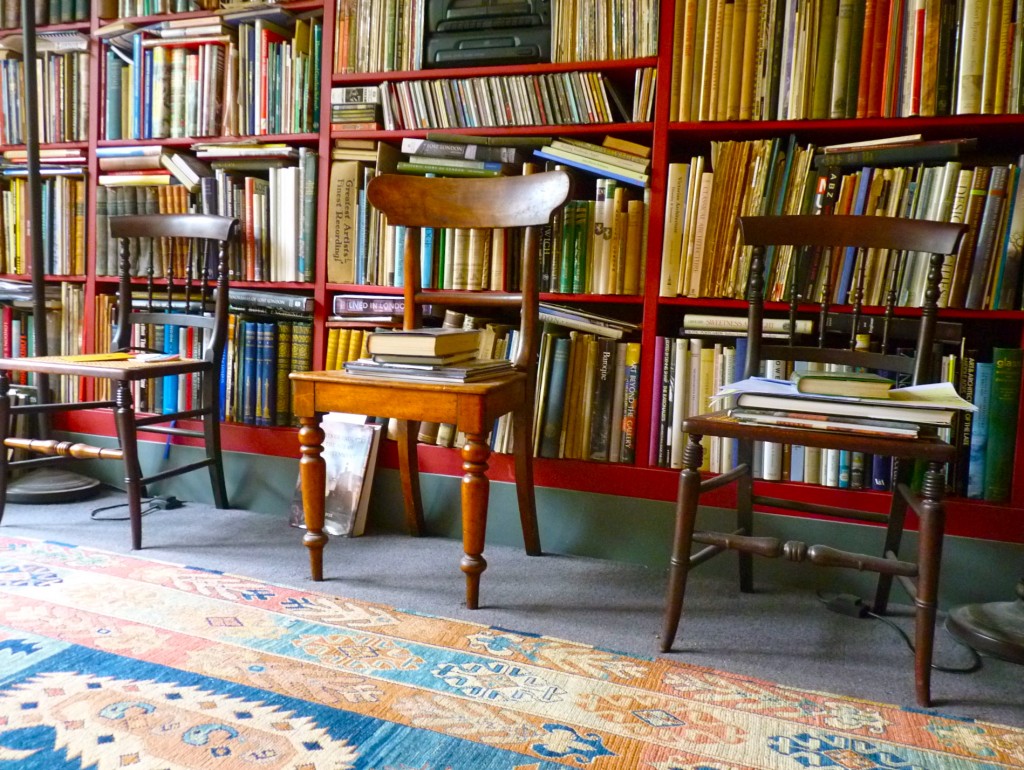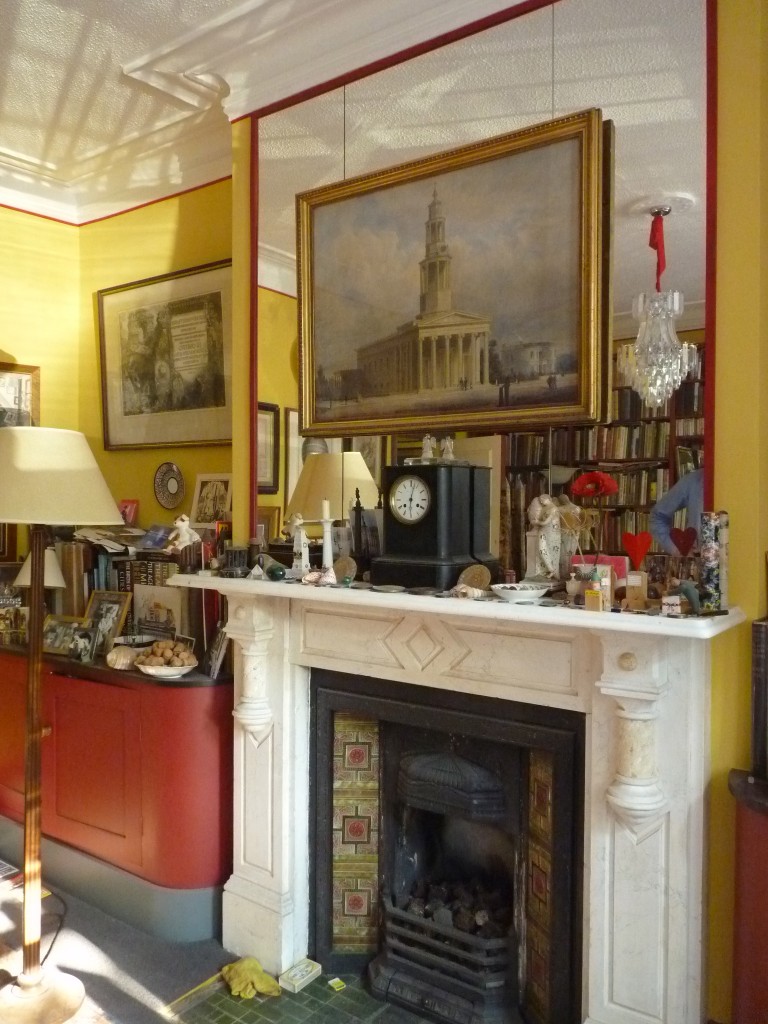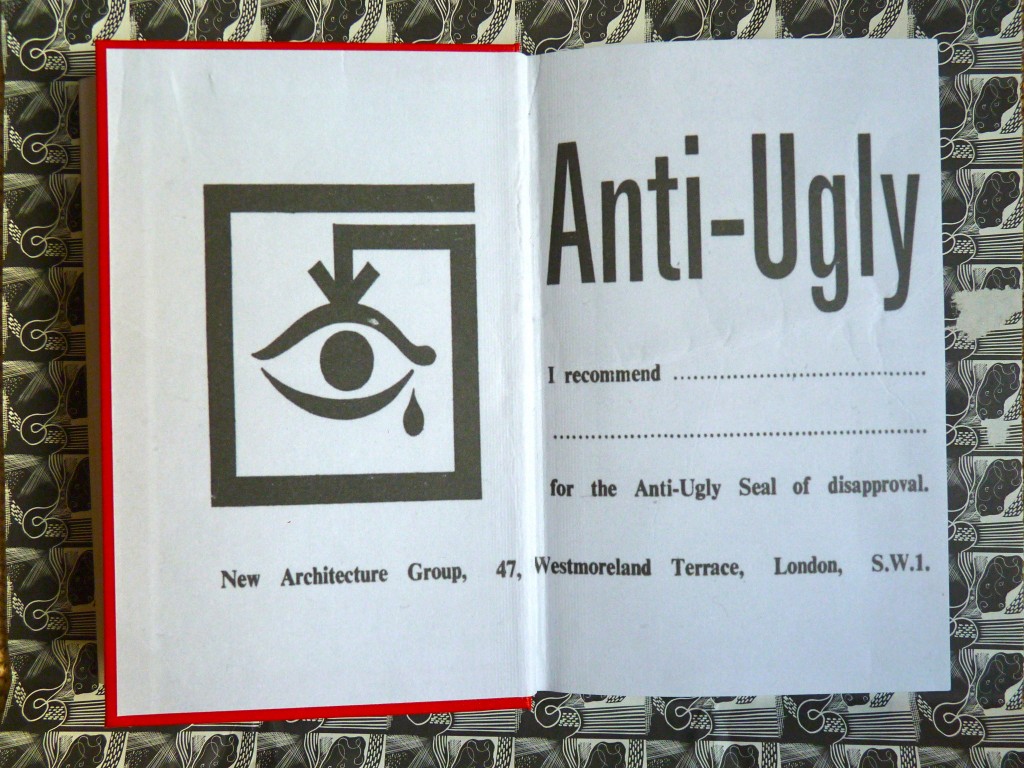The architectural historian and writer Gavin Stamp is one of the ‘new Georgians,’ pioneers of gentrification who brought up their families in the unloved and unlovely bits of London, where boarded up and multi-occupied old housing stock survived and could be had cheap in the 1970s and 80s. While Dan Cruickshank squatted in Hugenot houses threatened with demolition in Spitalfields and Glynn and Carrie Boyd Harte went to Islington, the Stamps came to rest in Chad Street, within a few hundred yards of St. Pancras Station. The two atmospheric pictures below were taken there, by that non-pareil Derry Moore for Alvilde Lees-Milne’s rather brilliant book, The Englishman’s Room.

Three years ago we bought this standard Late Georgian Forth Rate terraced London house, (Gavin Stamp wrote in 1980 in The Englishman’s Room, ) built the year Beethoven died…. once a sleazy lodging house, or worse, for this area used to be better known for red lights than for elegant facades. This was fortunate and not only because the house was cheap. In smart parts of London, houses have been modernised and restored over and over again, so that practically nothing original is left. Here, the chimneypieces had gone but everything else – doors, staircases, cornices, etc, – albeit punctuated by tiresome holes for Yale locks or for the water and waste pipes which served the basins which once graced every single room… The back drawing room now has a fine reeded marble chimmneypiece of authentic date which was a wedding present from the Fitzalan Puirsuivant Extraordinary, that is, the architectural historian John Martin Robinson ( two chimneypieces from Dan Cruickshank are elsewhere in the house). …The principal chimneypiece in the front drawing room we actually bought.

Although fitted up with chandeliers and furnished with Indian rugs, the two drawing rooms remain undecorated. On moving in, the first thing we did after throwing out piles of slug-ridden mattresses , was to hire a ‘steam-stripper’ and get layers of paper off the walls. This had a curious side effect. The steam fug condensed on the ceiling and mixed with the rich deposit of cigarette smoke to drip on our bare shoulders as liquid nicotine. [This room remained undecorated as long as they lived there.] I suppose I can imagine the buff cracked plaster looking rather Palladian and chic, Stamp wrote. Indeed, to get a clever stainer and grainer to achieve this decaying palazzo effect would be very expensive. As it is, it is very economical, as is the treatment of the joinery. The Bloomsbury mottled finish is achieved by the inept use of a blow-lamp.
Conservation fogeys love expressing opinions. They bang on about COUNTY BOUNDARIES (‘they can call Yorkshire what they like. I come from the NORTH RIDING and PROUD of it’); ABOLITION OF TELEGRAMS (‘I shall write to the Post-Master General’); OPEN-PLAN TRAINS (‘the crack of ring-pull cans was DEAFENING!’); CENTRAL HEATING (‘don’t be so FEEBLE. It will split your mahogany’); FITTED CARPETS IN CHURCHES (`absolutely OUTRAGEOUS’); BUILDINGS BY AGEING MODERNISTS (‘meretricious TAT’)…NOUVELLE CUISINE (‘had to eat a CHEESE SANDWICH on the way home’); MICROWAVE OVENS (laughter in the house); Then, plop, the Spectator falls through the letterbox and Mr Fogey sits in COMPLETE SILENCE and reads it.
The most time-consuming thing in Mr Fogey’s life, apart from campaigning, is a house, or when he is a poor Very Young Fogey, a basement or garret flat in the right sort of house. Fogeys differ from young Sloanes in the way they look at London property. Sloanes choose the area they want to live in and then find a house. Fogeys find the perfect house to restore and don’t give a damn about the area. They go where the architecture is and this is usually the rotting Georgian centres of big cities. Fogeys like Places to be socially crunchy …Mr and Mrs Fogey like to live in decaying splendour with wonderful, slightly broken things. They love costly tatters, the aristocratic aesthetic of pleasing decay. Their walls of patchy bare plaster give the Crumbling Palazzo Look. It is like hanging pictures on the inside of a Stilton. To go with that they like old china repaired with brass rivets.
To repair their houses properly, fogeys invented architectural salvage. Miles away when philistines are gutting an old house, fogeys pick up high-frequency distress signals. Suddenly, they are there, saving the bits if they can’t actually stop the destruction. Cracked marble fireplaces, panelled doors masked by crude hardboard flushing, sash windows, shutters, Carron grates and strangely brilliant old glass are mourned over and carried home. Another good building RIP. When a demolition pickaxe shatters the work of the human hand, fogeys feel it is a blow against humanity. If an old house is modernised with a new crudely-panelled front door, fogeys call the style Kentucky Fried Georgian… Like playing with Leggo they swop building bits (one small Georgian reeded marble fireplace broken in three places equals a big cast- iron bath on claw feet).
Fogey families believe in conservation heroics. They live with no roof, then no floors, then only a few walls, but lots of dry rot, Greek builders drinking Coca-Cola, collapsing ceilings, cold water, layers of filth, cellars full of old tights and tea- leaves, re-wiring by day, re-plumbing by fly-by-night and donating the drawing room as an emergency campaign office. Fogeys learned to rough it in the early Seventies. They trained as conservation commandos in squats and Direct Action against London’s rapacious property developers.

Stamp’s first bachelor flat, recorded for posterity in a watercolour by the talented designer, critic and art historian Alan Powers.

After a restoring a much larger house by the nineteenth century architect Alexander ‘Greek’ Thomson in the 1990s while teaching at the Glasgow School of Art’s Mackintosh School of Architecture, Gavin Stamp returned to London and a mansion flat on the south side of the river. The watercolour perspective of St. Pancras New Church hangs here, over another handsome white marble chimneypiece. The rich red and yellow colour scheme is neo-Victorian, a Peter Blake Pop Art take on a nineteenth century palette.

I cannot abide walls without pictures and, ideally, I would like them from floor to ceiling.there cannot be too many. I have absolutely no sympathy for that austere, puritanical, joyless approach which demands no clutter and just a few choice objects in a room of awful, boring, whiteness. Such rooms are not for real, clumsy human beings. I would rather have lots of moderately good things than one exceptional object, Stamp wrote in 1980.


As for the furniture … the important thing is that tables should be able to bear the weight of piles of books and that chairs should perform as filing cabinets.

HIs latest book, Anti-Ugly, Excursions in English Architecture and Design, is published by Aurum Press on November 7th. It’s an anthology of the best of his monthly columns written for Apollo magazine.

The piece from which it takes its name is the story of ‘Anti-Ugly Action,’ initiated by a group of students from the Stained Glass Department of the Royal College of Art, who demonstrated outside new buildings which they found offensive in the late 1950s.
They printed cards on which members of the public could recommend buildings for the ‘Anti-Ugly Seal of disapproval.’ Many of the buildings which they condemned were essays in modern Classicism by progressives such as Sir Albert Richardson, for the anti-uglies were actually crusaders for Modernism. Stamp tells their story in order to explore the complicated history of architectural taste and changing perceptions of ugliness, then and now.
His views are often heterodox, he questions Sir John Soane’s current status as a superstar while insisting on the brilliance of the self-taught Neo-Classical sculptor Alexander Stoddart, a ‘Canova for today.’

The writer at home, 2013. Gavin Stamp was a friend of the poet and lover of architecture John Betjeman. Inspired, perhaps, by his example, he chose the life of an architectural historian-at-large, unattached to any academy or institution, although he teaches at several. He is a crusader for some of the causes that Betjeman espoused, and some more of his own. He writes the ‘Piloti’ column for Private Eye, which Betjeman originally founded and then passed on to him.

Anti-Ugly by Gavin Stamp, is about the Englishness of English architecture, its preservation, restoration, demolition and neglect, a trenchant, opinionated excursion around the architectural legacy which we have inherited, and to which we are so frequently dangerously indifferent. [All images copyright Derry Moore/ bibleofbritishtaste]





Just love those mustard-yellow walls with the red line at coving height, to match the bookcases! Wasn’t it John Fowler who used to do this, too, or another interior decorator? A gorgeous room, so full of character as well as books, paintings and other interesting memorabilia.
Very much enjoyed your recent post. I am a Ben Pentreath admirer, French American living in Paris with two daughter’s studying and loving London. Kind regards.
Love the blog!
The Alvilde Lees-Milne book is certainly wonderful. I remember a friend borrowing my copy and how on seeing a photo of a coal-miner that appeared in another photo on the pages on Gavin Stamp’s room she exclaimed in tones of withering contempt: ‘Oh, Gavin Stamp!”.
That Speccie article, Kentucky Fried Georgian, was probably the one that did most to turn me (for ten years) into a Spectator reader, as it was included in an anthology of Spectator articles that fell into my hands.
I’d not come across the Kentucky Fried Georgian article before today but it further concretes Gavin Stamp as someone worth keeping up with.
I bought Anti-Ugly a few weeks ago and am making my way through the essays one-by-one when it’s quiet at work. He is an interesting and eloquent writer and someone taking on the mantle of Nairn for being neither too much of a historicist or too much of a modernist.
Trust him to live in such a beautiful house (both the Georgian and Victorian one!)
I’ve always thought Stamp’s first home was lovely. The second is equally lovely, but missing a bit of the squalidness of the first. I have to say that I’m glad it doesn’t have a whiff of overly precious classicism and an aura of “look, but don’t touch/we don’t actually do our filing on the dining room table, thank you/I might be posh, but I’ll settle for middle class mundane-ness”. Stamp’s homes are, and I suspect always will be, fully lived in and lived into. What you see is what you get and the man’s filing, odd bits and bobs and ink stains on the carpet all come with him. Thank you very much.
I never ever thought of myself as being a type, but now I know, I am a Fogey, albeit one without the means to live in even a 4th rate London townhouse.